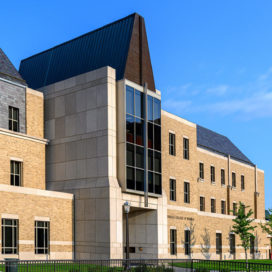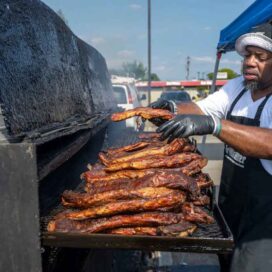Gas pains ease; Drivers desensitized
Published: June 26, 2005 / Author: Andrew Leonard
Admit it — you used to shudder at the thought of shelling out $2 for a gallon of gasoline.
But if you are anything like Anna Hickner, your expectations have changed.
“Now? For the summer I’d be happy if it stayed at $2,” said Hickner, a Saint Mary’s College student, as she recently pumped gas at a Roseland gas station.
“Compared to four or five years ago, it’s so much different.”
Gas prices that first drew consumers’ ire months ago are now commonplace at gas stations across the country.
But aside from the occasional grumble when a sudden price spike dents consumers’ wallets, customers like Hickner now just shrug their shoulders when they go to fill up.
“They’ll charge what they want,” South Bend resident Chuck Wynegar said, “and we’re still going to pay it.”
Gas prices have increased 34 percent since the year began. But experts say that consumers’ psychological acceptance of higher prices is the product of their gradual increase over the past several years.
Paying $2 a gallon used to be unfathomable, customers once said. But the fact that Americans regularly pay more now suggests gas prices could still climb higher, and consumers would still open their wallets.
“What’s the price that people would be willing to pay before they stop purchasing it altogether?” asked John Gaski, an associate professor of marketing at the University of Notre Dame. “I have no idea.”
Gradual acclimation
Consumers get used to higher gas prices in the same way a frog in the old folk tale gets boiled to death — slowly.
They simply get used to paying more over time.
Consumers have internal and external price reference points, said Bruce Wrenn, professor of marketing at Indiana University South Bend.
The external references are the advertised prices. The internal ones are based on a consumer’s memory of what has been paid for a particular product before.
Internal references have a range, said Wrenn. If an advertised price falls into the range, then the consumer will assimilate it.
But a too-big jump in price that falls outside the range is not likely to be accepted as valid and consumers will change their behavior — at least for a time.
Wrenn said there was a similar situation in the 1970s when coffee shot up three-fold in price in a matter of months.
For awhile, people drank tea and other beverages before shifting back to coffee gradually as the prices declined.
For many years, $1 was the threshold price for gas, said Wrenn. As long as the “1” was the first digit in the price, though, people adapted. Then $2 became the threshold.
Now Wrenn thinks $3 is the next big mental roadblock.
“So if you drive by a gas station and see a price of $3.50 per gallon, then that’s currently outside the price range,” said Wrenn. “But if the price is $2.50, you might just think, ‘Well, that’s just the way things are and that’s the way things are going to be.’ And you assimilate that price.”
Imagine a five-week steady increase in gasoline prices, where the per-gallon rate climbs three cents a week.
Marketing professors said consumers would handle those gradual increases better than one sudden 15-cent jump.
“What’s happening is basically we are ratcheting up the reference price that we use in judging what seems to be a plausible price,” said Wrenn. “As long as it’s in small increments, we will adjust our internal reference price and we won’t restrict consumption.”
However, consumers haven’t reacted as angrily to the current surge in energy prices as they did in the late 1970s — something Gaski of Notre Dame attributes to a better-informed public.
Back then, cars followed tankers to fueling stations and conspiracy-laden tales of oil tankers waiting in the Gulf of Mexico sparked cries of protest.
But now, most consumers know that turmoil in the Middle East or hikes in crude oil prices (which flirted with the $60-per-barrel level last week for the first time) will translate into higher fuel prices.
“We’ve had 25 to 30 years to think about the oil market,” Gaski said. “We’ve gotten more information now than there ever was before, and maybe its obvious that it’s supply and demand.”
Effect on consumers
Gaski speculated that consumers won’t cut down on their driving any more than they already do, simply because they’ve minimized their driving when gasoline prices started to climb earlier in the decade.
And while there is evidence of changing consumer behavior — sales of gas-guzzling sport utility vehicles are down, while car dealers can’t keep enough fuel-conscious hybrids in stock — it’s hard to say whether consumers actually adjust their lifestyles based on rising gasoline prices.
Take Violet Masterson, a South Bend resident who works in LaPorte.
“I’d consider anything less than $2 cheap (now),” Masterson said. “I just pay it (more than $2) because I have to.”
Families with extremely tight budgets may have to take some conservation measures because they simply don’t have the extra money.
But most people resist change.
“People just don’t want to accept the idea that they cannot do something they’ve always been able to do, simply because gas prices have gone up,” Wrenn said.
“We’ll talk about it and we’ll complain about it, but we won’t change our behavior until it’s really painful.”
For the past three years, AAA travel club has found motorists are hitting the road in record numbers for each major holiday, despite gas prices.
The reason is fuel costs even at $2 per gallon and higher don’t constitute much of the overall vacation cost.
According to AAA, the average U.S. family can expect to spend about $77 on gasoline during its longest driving vacation this summer. This is about $17 more than a year ago when average summer gas prices were considerably lower than today. On Friday, AAA recorded a national average price of $2.19 per gallon, nearly 30 cents more than a year ago.
But one outcome of the higher gas prices is that people are sensitized to price differences among area gas stations, said Wrenn.
Some consumers will drive across town if a station is 10 cents per gallon less, even if they have to use more gas to do so.
“People will do all sorts of irrational things when it comes to this,” said IUSB’s Wrenn. “In the grand scheme of things, you’re talking of saving just pennies or dollars.
“But some people will go way out of their way because they are devoted to the idea of saving money.”
Current gas prices have a long way to go before they reach the $3.08 inflation-adjusted record set in 1981.
There is a price at which consumers will decide when gasoline costs too much, and significantly cut back driving in favor of public transportation or bicycles, Gaski said.
But nobody knows what that price point is.
“If we’re willing to pay up to $5 per gallon,” Gaski said, “that means we value the product up to that.
“And that means, when we pay less than what we are willing to pay, then we actually think we’re getting excess value.”
/news_and_events/news_articles/article/3737/gas-pains-ease-drivers-desensitized
Related Stories




